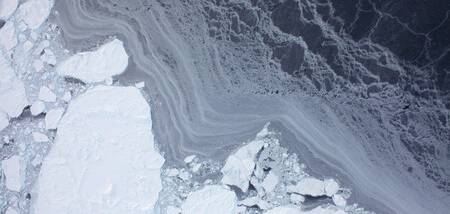
September marks the end of the summer season of ice melting and the minimum of Arctic sea ice , where sea ice above the ocean in the northern hemisphere reached its lowest extent of the year.
For ship captains hoping to navigate the Arctic, this is usually their best chance to do so, especially in recent years. The sea-ice cover has decreased by about half since the 1980s as a direct result of the increase in carbon dioxide from human activities.
Two NASA scientists are analyzing for us the causes and consequences of the change in sea ice. In 2021, the sea ice cover in the Arctic reached its minimum extent on September 16. Although it was not a record, a look back through the melt season provides an overview of the incessant decline of Arctic sea ice to climate change.
The Arctic r e heaters
In recent years, sea ice levels in the Arctic have been at their lowest since at least 1850 for the annual average and for at least 1,000 years in late summer, according to the latest assessment. climate change from the UN Intergovernmental Climate Panel. The IPCC concluded that "the Arctic is likely to be virtually free of sea ice in September at least once before 2050" .
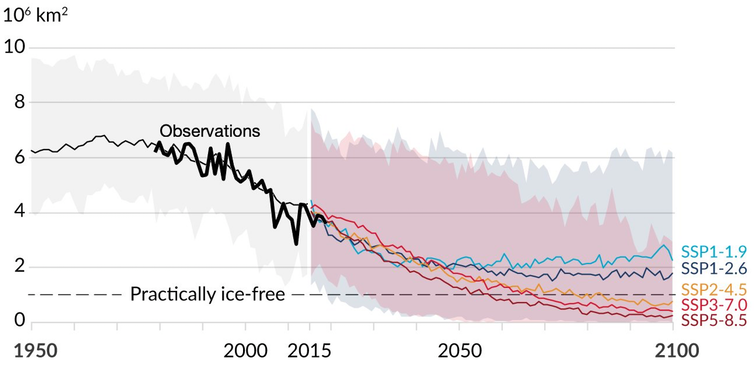
Qu blink of Arctic sea ice (black line) and projections for the future in five sc e ios. NSIDC Ed Hawkins
As the bright Arctic ice is replaced by a darker open ocean surface, less solar radiation is reflected back into space, causing further warming and loss of ice. This feedback loop albedo is only one of many reasons why the Arctic is warming about three times faster than the planet as a whole.
"The albedo, or albedo, is the reflective power of a surface, that is to say the ratio of reflected light energy to incident light energy. It is a dimensionless quantity, comparable to the reflectance, but of more specific application, used in particular in astronomy, climatology and geology. " 1
That is it happened ed to sea ice in 2021?
The backdrop for this year's minimum sea ice was prepared last winter. The Arctic has experienced an anomalous high pressure system and strong clockwise winds, dragging the thickest and oldest sea ice in the central Arctic into the Beaufort Sea to the north. from Alaska. The sea ice scientists were taking note.
The summer melt began in earnest in May, a month that was also the month of several cyclones entering the Arctic. This increased sea ice drift, but also kept temperatures relatively low, limiting the amount of melt.
The extent and rate of the melt increased significantly in June, with a predominantly low pressure system and temperatures a few degrees above average.
In early July, conditions were approaching the all-time low set in 2012, but the rate of decline slowed significantly in the second half of the month. Cyclones entering the Arctic from Siberia generated counterclockwise winds and ice drifts. This counterclockwise ice flow pattern generally reduces the amount of sea ice moving out of the Arctic through the Fram Strait east of Greenland. This likely contributed to the record summer sea ice conditions observed in the Greenland Sea.
This pattern of ice circulation has also increased the export of ice out of the Laptev Sea off Siberia, helping to create a new record low for the early summer ice area in that region. . The low pressure system also increased cloudiness over the Arctic. Clouds typically block incoming solar radiation, reducing the melting of sea ice, but they can also trap waste heat from the surface, so their impact on melting sea ice can ultimately result in a very high balance sheet. mixed.
In August, the decline of sea ice slowed considerably, with warm conditions prevailing along the Siberian coast, but also cooler temperatures over northern Alaska. The Northern Sea Route - which Russia has promoted as a global sea route as the planet warms - has in fact been blocked by ice for the first time since 2008, though frequent crossings by breakers- ice creams are still possible.
At this point in the melt season, the pack ice is weakest and responds very well to weather conditions on a given day or week. Subtle changes can have big impacts. The monstrous weather events of late summer were linked to the record low sea ice years of 2007 and 2012.
“The Great Arctic Cyclone of 2012” is an interesting example.
There is an ongoing debate about the effect they have. However, scientists are largely agree that specific storms may have not played an important role in driving record lows over the years - things are never as simple as which concerns weather and sea ice.
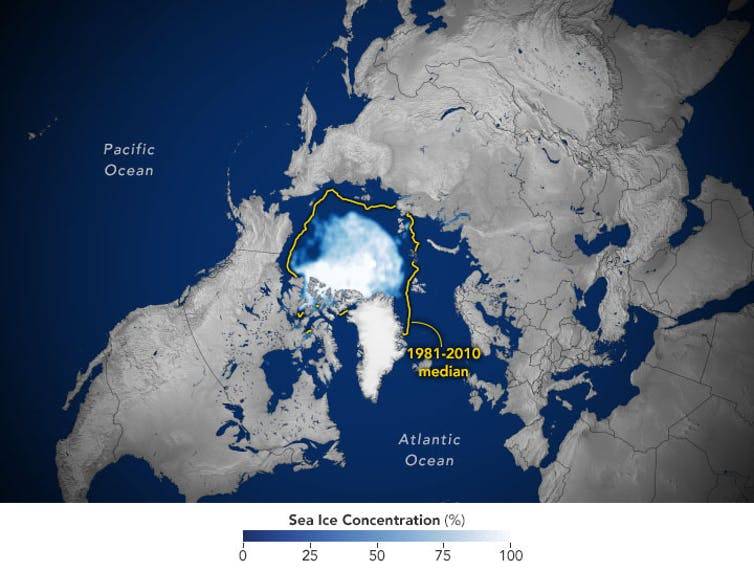
Arctic sea ice reached its minimum tense ed 16 September 2021 Earth Observatory NASA / NSIDC
Arctic sea ice reached its minimum extent of 2021 on September 16, reaching 4.72 million square kilometers (1.82 million square miles), the 12th lowest on record.
Thus, the melt season 2021 was, despite all the risks, rather typical of our "new Arctic" , the minimum ending in September to a level slightly higher than what we would have expected the downward trend long-term. But various new records were set in other months and regions of the Arctic.
As the hours of sunshine decrease over the next few weeks and temperatures drop, Arctic sea ice will begin to freeze. The pack ice will thicken and expand as the surface temperatures of the surrounding ocean drop towards the freezing point, releasing much of the heat that was absorbed and stored during the summer.
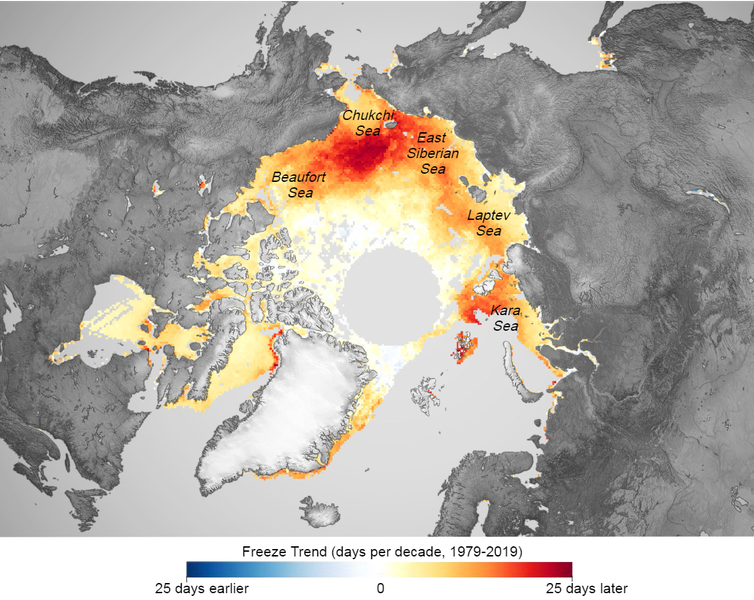
W here Arctic sea ice forms later in the season. Joshua Stevens / Earth Observatory NASA
This refreezing started later in recent years, moving into October and even November. Over the ocean gaining heat in the summer, the more heat must be lost before the ice can begin to form. For this reason, some of the biggest warming signals are actually seen in the fall, despite all the attention given to summer ice loss.
There are still many things we do not know
For people who live and work in the High Arctic, it's really important to understand the local ice conditions on any given day or week. And predicting how Arctic sea ice will look on more local scales is even more difficult.
As 2021 has demonstrated, sea ice is very dynamic - it moves and melts in response to the weather conditions of the day. Think how difficult it is for forecasters to predict the weather where you live, with a good understanding of weather systems and plenty of observations available, compared to the Arctic, where few direct observations exist.
Weather events can also trigger local feedback loops. A monstrous heat wave, for example, can trigger the ice to melt and further warming. Winds and ocean currents also break and spread ice across the ocean, where it may be more prone to melt.
Sea ice scientists are working hard to try to understand these various processes and improve our predictive models. A key missing part of the puzzle for understanding sea ice loss is the thickness of the ice.
The thickness multiplied by the area is equal to the volume. Much like this region of the globe, the thickness of sea ice is thought to have halved since the 1980s, which means that today's Arctic sea ice weighs only about a quarter of the volume that was his only a few decades ago. For those hoping to navigate the Arctic Ocean, knowing the thickness of the ice they may encounter is crucial. The thickness of sea ice is much more difficult to measure consistently from space. However, new technologies such as ICESat-2 offer decisive breakthroughs.
Despite all this uncertainty, it seems quite likely that the arctic conditions in which the ice will have completely disappeared in summer are not too far away. The good news is that the way forward still depends largely on future emissions, and there is still no evidence that the planet has passed a tipping point of sea ice loss, which means humans are still at the controls.
Sources :
![]() Linette Boisvert - Sea Ice Scientist and Assistant Project Scientist for Operation IceBridge from NASA, NASA
Linette Boisvert - Sea Ice Scientist and Assistant Project Scientist for Operation IceBridge from NASA, NASA
![]() Alek Petty - Associate Researcher in Polar Sea Ice Variability, NASA
Alek Petty - Associate Researcher in Polar Sea Ice Variability, NASA
Posted on 2021-09-27 17:53

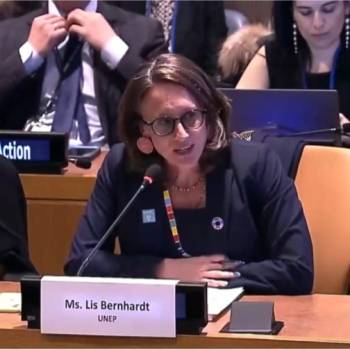






Comments